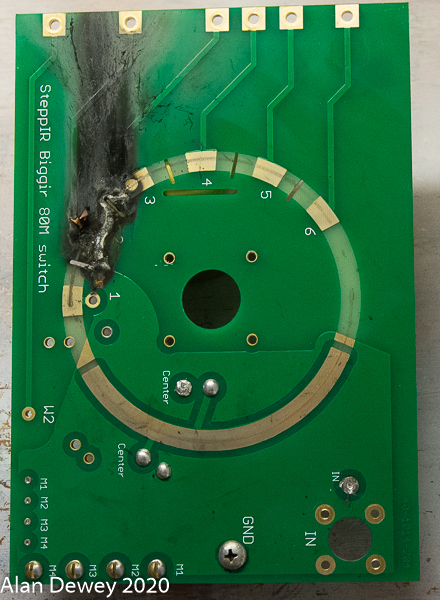Repairing a Steppir Biggir Vertical – part 1 – Diagnosing the Failure

I do not know what caused this disaster to begin. I will assume that somewhere along the line I did something wrong. Why? Because I had been happily using the Steppir Biggir with 80 m coil kit for about 10 months, often at about 700 W out of the amplifier.
Before we proceed, I would like you to note that the Steppir SDA-2000 antenna controller has a nice feature that I used since day one. It has a relay output that can prevent you from transmitting while the antenna is adjusting its length. Like many rigs out there, the Ten Tec provides TX Out and TX Enable from the rig to the amplifier. Those signals prevent the exciter from creating RF until the RF relay in the amplifier finishes closing, so we never have RF on relay contacts until they have made good contact.

By routing the TX Out and TX Enable signals through the relay contact of the SDA-2000 controller, we now have prevented the rig from creating RF when the controller is adjusting the antenna. (If the controller is turned off, it will allow you to TX to a misadjusted antenna.)
Take a look at this photograph. It shows the PCB that holds the 80m loading coil and the stepper motor that turns the large rotor that selects the coil taps. On the bottom side of this board is a 4:1 transformer (2:1 voltage). This transformer is switched in when using any tap of the coil, so that if the antenna feedpoint impedance is 12.5 ohm, that it would be stepped up to 50 ohms to match our feedline.

In order of increasing inductance, tap 2 is used for 5 MHz, tap 3 is for 3.95 MHz, tap 4 is for 3.7 or 3.8 ish MHz, and tap 5 is the default for operating 3.5 to 3.6 MHz. Most of my low frequency operation is 3.55-ish for CW traffic.

Then one evening in March, I went up to 3.9 MHz to chat on SSB and I heard some unpleasant noises from my amplifier. Though I instantly shut my big mouth, I could see the reflected power meter had been to at least 5:1 and was on its way down now that power was off.
The evening that this failed was approximately the time that I switched to a ‘new’ amplifier. I do not remember exactly when I switched over to the Ten Tec Titan. Anyway, changing to a new-to-me amplifier does increase the likelyhood that the failure was not a Steppir Antenna problem, but more like episode of operator-rectal-cranial-inversion.
Taking some more time to inspect the board, we can see from the ‘hole’ in the smoke residue, that the rotor was set to coil tap 3. The board arced from tap 2 to the input trace and the ground trace.
After dismantling the assembly, cleaning, and inspecting, it appeared to me that the only damage was to the main PCB. The rotor board appeared to be fine.

The coil will be cleaned with acetone before installing on the new PCB.
UPDATE 2021-04 I now believe that I know exactly what has caused these failures. It is NOT the manufacturer’s fault ! Jump to the ‘solution’ here https://blog.secondhandradio.com/2021/02/steppir-biggir-failed-again/ the first 6 articles in this series will remain here as an example of troubleshooting, analysis, and repair of this antenna.
This adventure continues in part 2.



This is NOT a common problem, but not unheard of. Here is a reflector thread on the same subject. https://groups.io/g/steppir/message/824